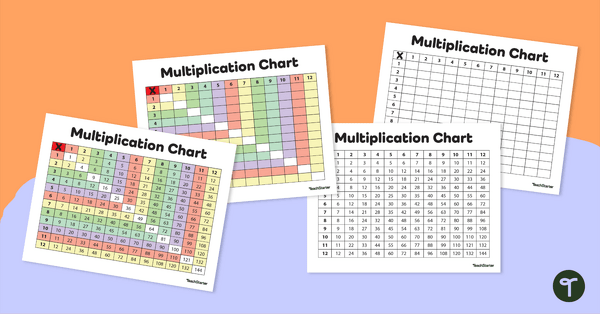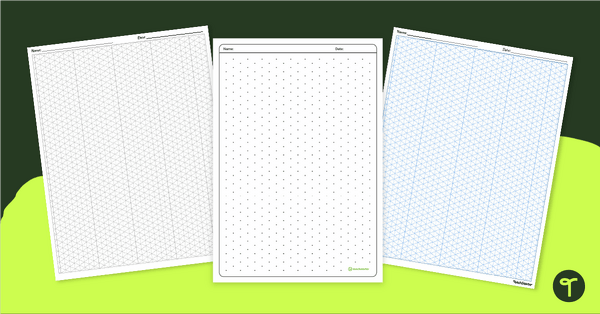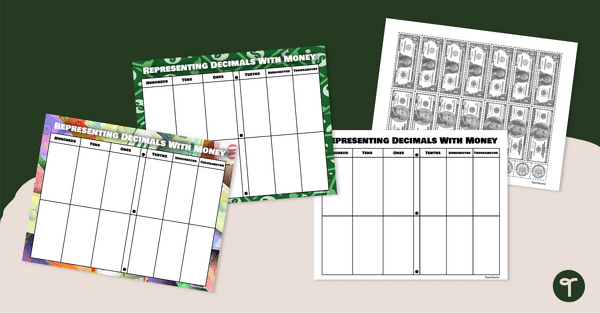Math Manipulatives Teaching Resources
Explore printable and virtual math manipulatives created by teachers to make your math teaching journey a little bit easier this school year!
Are you looking to foster a deeper understanding of mathematical concepts and emphasize hands-on learning? Our teacher team has you covered!
From handy multiplication charts to printable protractors, this collection of teaching resources is stocked with everything you need to provide concrete experiences for your students that will complement the abstract mathematical ideas you're tackling each day.
Curious about getting the most out of the math manipulatives in this collection? Read on for a primer from our teacher team, including a look at our best tips for storing all those manipulatives!
What Are Manipulatives in Math?
Yes, we know it sounds obvious to many, but we had to start somewhere!
A math manipulative is a concrete object that a learner can use to explore a mathematical concept in a hands-on way. Students literally manipulate these objects with their hands — hence the name!

These informal measurement rulers are a fun math manipulative that help kids better understand the concept of measuring length.
Why Are Manipulatives Important in Math?
Wondering if you really need to add even more things to your classroom that are going to take up space? Well ... yes ... manipulatives are important for your students to use, whether they're working in math centers, guided math groups or doing individual tasks.
Let's face it — if you had the choice between doing math worksheets all day or getting to be more hands on, which would you choose? Worksheets certainly have their place in math education (it's why our teacher team creates engaging and interesting worksheets in the first place), but we can trace the use of manipulatives in math education back throughout history to the work of various educational theorists and mathematicians.
And for good reason!
Manipulatives make learning math more fun for kids, and these handy tools also give kids a way to bring these abstract concepts into the physical realm.
A Look at the History of Math Manipulatives
Friedrich Froebel — the German educator best known for developing the concept of kindergarten in the early 19th century — was one of the earliest advocates of what we call manipulatives today.
Froebel believed kids should be encouraged to learn through play and exploration, using objects and materials to develop their understanding of mathematical and spatial concepts.
In the mid-20th century, researchers like Jean Piaget and Jerome Bruner added themselves to the list of education experts advocating the use of concrete manipulatives in mathematics education. They both argued that young learners should progress from concrete experiences to abstract thinking, with manipulatives providing a bridge between the two.
Today, using math manipulatives is widely supported and integrated into elementary school classrooms as a way to provide kids with a means for hands-on learning and a way to support a diversity of learners.
Manipulatives cater to visual, tactile, and kinesthetic learners, with makes them a perfect way them to engage with math in ways that suit their individual preferences.
Teacher Tips for Storing Math Manipulatives in the Classroom
Base 10 blocks. Counters. Tangrams. Dice. We could go on and on because there are a LOT of different kinds of manipulatives for math.
So how do you keep track of all of them without chaos ensuing in the classroom? Here are some of our teacher team's tips for keeping it all organized.
- Use pencil boxes or pencil pouches to store your base 10 blocks.
- Pull out zipper bags to store different manipulatives — the different sizes of the bags can be used for different types, such as a snack-sized bag for your artificial coins.
- Create individual manipulative bins for each student with the child's name labeled on their bin and a lid to keep it all tightly inside.
- Purchase a rolling cart with small shelves already built in! This makes it easy to separate the manipulatives into their own sections, and the cart can be rolled out when it's time for kids to grab their fraction strips or those clock templates.
- Free Plan

Fraction Strips
Promote hands-on learning in your classroom with this set of printable fraction strips.
- Free Plan

Desk-Sized Multiplication Charts for Students
Download 4 desk-size multiplication charts so every student can keep their own chart handy!
- Free Plan

Printable Blank Number Line - 0-120
Create personal number lines for use in math lessons with a printable blank number line template for numbers from 1-120.
- Free Plan

Printable Play Money - US Paper Money & Coins
Add a real-world touch to your classroom lessons with a set of printable play money for kids!
- Free Plan

Printable Ten Frames (Single and Double)
Introduce these printable ten frames to your students to promote number sense with hands-on learning.
- Free Plan

Ten Frame Printable Templates
Use these printable ten frames in various math lessons to reinforce number sense and other essential skills.
- Free Plan

Blank Number Lines - Printable
Print a set of open number lines to help you teach a variety of math skills.
- Free Plan

Multiplication Chart
Print a handy multiplication chart for your students — it's free for teachers!
- Free Plan

12-Hour Clock Template
A template for an interactive clock that displays hours, minutes, and wording.
- Free Plan

Printable Protractor Templates
Teach your students how to measure angles using a protractor with these 180° and 360° printable protractor templates.
- Free Plan

Free Counting From 1 to 10 Activity — Hands And Numbers Template
Teach counting from 1 to 10 and one-to-one correspondence with a creative (and free) printable activity for preschool, kindergarten, or 1st grade.
- Plus Plan

Place Value Slider Set
Break out this place value slider set for a hands-on way to demonstrate multiplying and dividing whole numbers and decimals by powers of ten.
- Free Plan

Isometric Paper Templates - Dotted/Lined
Isometric Paper - Dotted Paper Printable
- Plus Plan

Money Place Value Chart Activity Set
“Bank” on this money place value chart activity set to make teaching decimal concepts a breeze!
- Plus Plan

Telling the Time Clock Template
Teach how to tell the time to the nearest five-minute increment with a hands-on printable clock template.
- Plus Plan

Digital Clock Template
Print an interactive digital clock template to practice telling time during daily classroom calendar lessons.
- Plus Plan

Large Multiplication Chart (Blank)
Use this 4-page blank multiplication chart to teach your students about finding products, multiples and number patterns.
- Plus Plan

Printable Rulers for the Classroom
Excite your students about mastering precise measurements with these centimeter, inch, ½ inch, ¼ inch and ⅛ inch printable rulers!
- Plus Plan

Base-10 Blocks - Pictorial Model Cards
A set of base-10 block cards to compose and decompose numbers, including decimals.
- Free Plan

Place Value Charts — Printable Math Mats
Practice place value concepts, addition, and subtraction with a printable set of free place value charts.
- Free Plan

Printable Number Line 0–30
Make counting a visual experience with this set of 4 multi-purpose 0–30 printable number lines.
- Free Plan

Free Printable Graph Paper — Centimeter Grid Paper
A piece of centimeter grid paper to be used in a multitude of ways.
- Plus Plan

Number Chart – 1-20
A bright number chart representing numbers 1-20.
- Plus Plan

Square Dot Paper - Dotted Journal Paper
Sheets of square dot paper templates.
- Free Plan

Tangram Pieces
A set of tangram pieces.
- Plus Plan

Bear Squares
A hands-on educational resource with so many applications!
- Plus Plan

Non-Standard Measurement Rulers
Use printable non-standard measuring rulers to introduce your little learners to the world of measurement.
- Plus Plan

QR Code Price Tags
A set 40 of QR Code price tags and a blank template to create your own.
- Plus Plan

Price Tags
A set of price tags to use in a variety of ways during your money unit.
- Plus Plan

Clock Template
Let your students learn how to tell time in a hands-on way with this clock template.
- Plus Plan

10-20 Digit Cards
A set of flashcards, including the numbers 10-20, to be used when teaching numbers and place value.
- Free Plan

0-9 Digit Cards
A set of 0-9 digit cards to be used for numeracy games in the classroom.